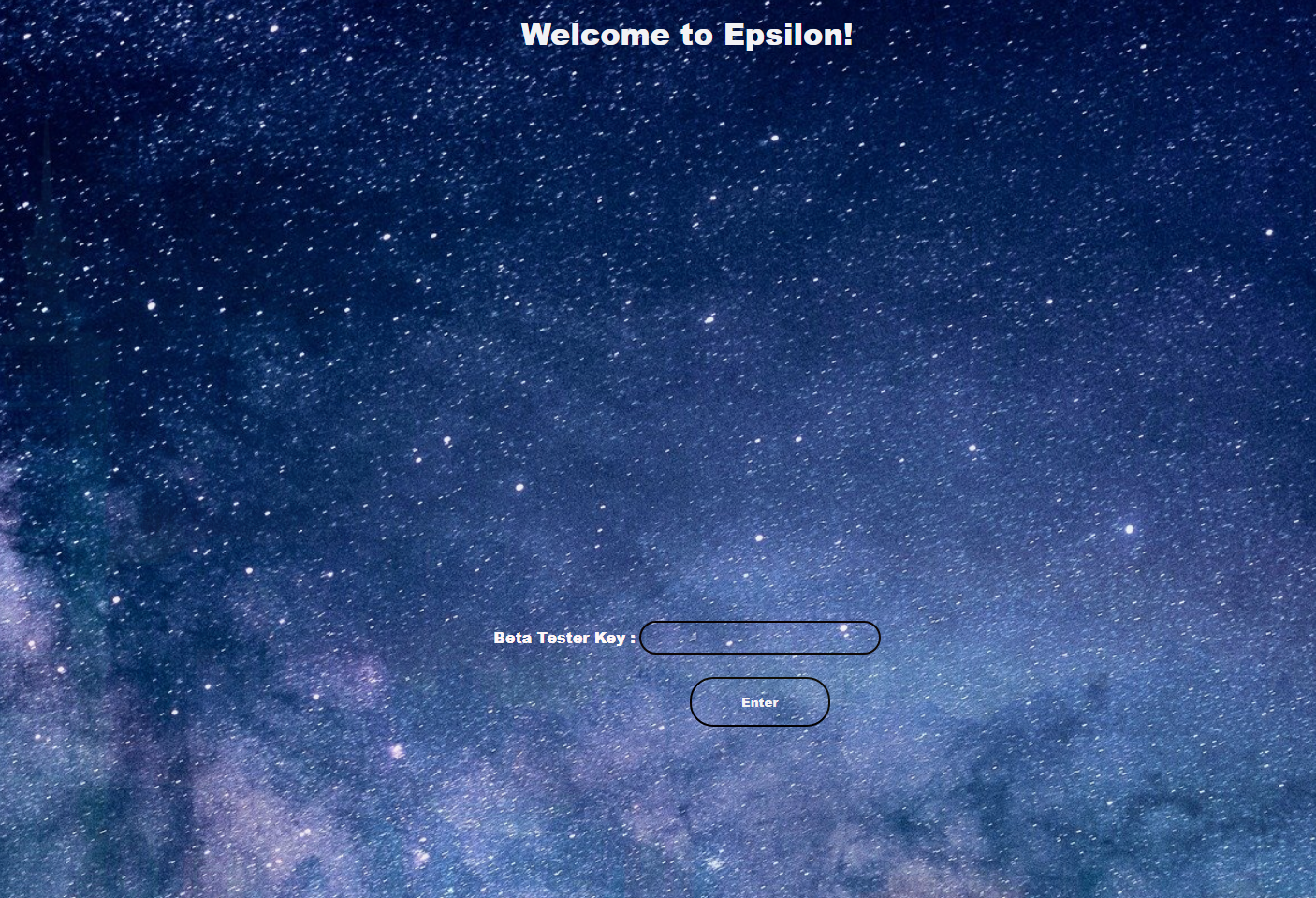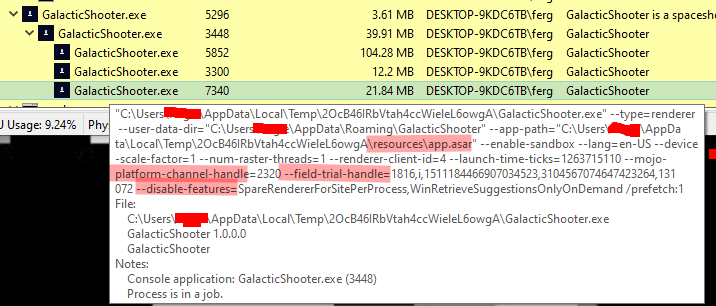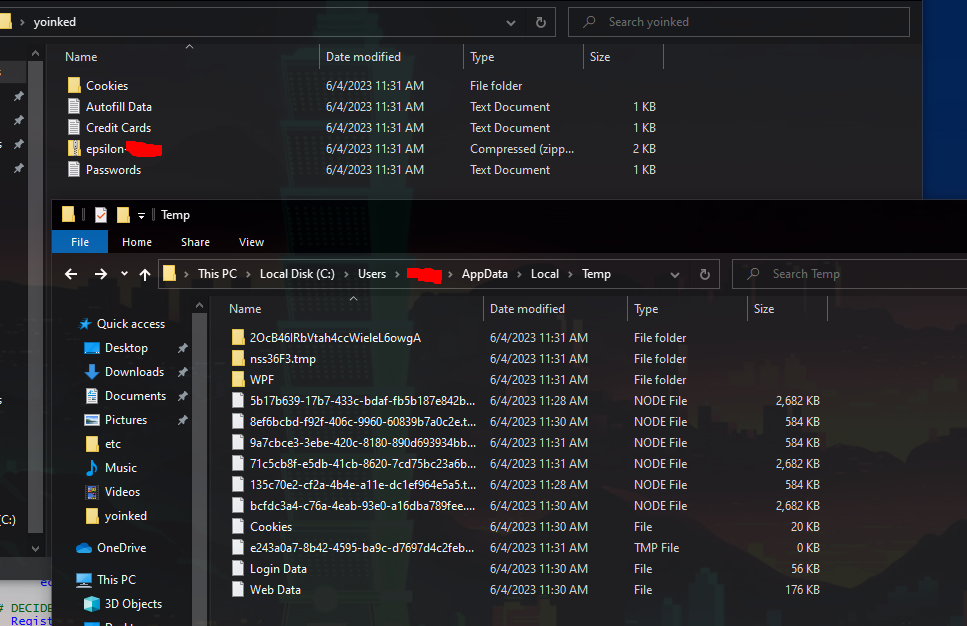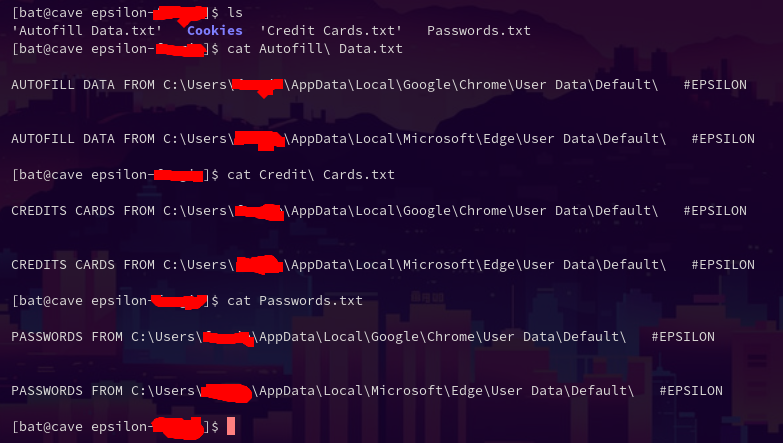AC1DF0X VAULT




password. Immediately, we find something interesting.
"4:04:25.7873536 PM","GalacticShooter.exe","1580","CreateFile","C:\Users\USER\AppData\Local\Temp\epsilon-USER\Passwords.txt","SUCCESS","Desired Access: Append Data/Add Subdirectory/Create Pipe Instance, Write EA, Read Attributes, Write Attributes, Read Control, Synchronize, Disposition: OpenIf, Options: Synchronous IO Non-Alert, Attributes: N, ShareMode: Read, Write, Delete, AllocationSize: 0, OpenResult: Created"
WriteFile from GalacticShooter.exe with the string "epsilon" in it returns the unique files:
C:\Users\USER\AppData\Local\Temp\epsilon-USER\Passwords.txt
C:\Users\USER\AppData\Local\Temp\epsilon-USER\Cookies\Chrome_Default.txt
C:\Users\USER\AppData\Local\Temp\epsilon-USER\Cookies\Edge_Default.txt
C:\Users\USER\AppData\Local\Temp\epsilon-USER\Credit Cards.txt
C:\Users\USER\AppData\Local\Temp\epsilon-USER\Autofill Data.txt
C:\Users\USER\AppData\Local\Temp\epsilon-USER.zip
epsilon-USER.zip. From the first write event of Passwords.txt to the deletion of epsilon-USER.zip is about 5 seconds. Given a wide time-frame, we have the opportunity to snag it for ourselves when the files write to disk.
$watcher = New-Object System.IO.FileSystemWatcher
$watcher.Path = "C:\Users\USER\AppData\Local\Temp\"
$watcher.Filter = "epsilon-USER.zip"
$watcher.IncludeSubdirectories = $true
$watcher.EnableRaisingEvents = $true
$action = { $path = $Event.SourceEventArgs.FullPath
cp $path "C:\Users\USER\Desktop\yoinked\"
echo "success"
}
Register-ObjectEvent $watcher "Created" -Action $action
Register-ObjectEvent $watcher "Changed" -Action $action
Register-ObjectEvent $watcher "Deleted" -Action $action
Register-ObjectEvent $watcher "Renamed" -Action $action
while ($true) {sleep 1}
GalacticShooter.exe process does not perform a check to ensure the data is not a duplicate and thus, after minor trial and error, we can snag the files.


GalacticShooter.exe, further reinforcing its Electron behavior. The folder 2OcB46IRbVtah4ccWieleL6owgA also contains the child process GalacticShooter.exe that we saw above in Process Hacker.
\2OcB46IRbVtah4ccWieleL6owgA\GalacticShooter.exe [38c81e9d17174f56bf3c22e5994d341ad041254ada2743160b69d893b8d51eda] has even less prevalence in VT. It does, however, offer us a bit of insight into the greater campaign.

| PARENT | SHA256 |
|---|---|
| Palowarn_DEMO.exe | 3862b39cbaca21c0a4e1c4ee09c83ab8dca7fdafe90486115ca30d74339aa435 |
| TBMSetup.exe | 1fb52505b4b5a857d33c65dbc433cb8259312ee91a9fd23f8a6b7820e5426c18 |
| TBM_Setup.exe | 09f0a812f6e111d15cb40ab484cb696f3f510247e618c73add4f445f267cef76 |
| Saturne-SpoofX.exe | 0c69121b796701d5f1643ca0358f975b551004425b467f8ccd52b0cbcaa7d161 |
| Condo_Generator.exe | 04fb70c81a5f3f2c2310e0ff166b2b2956fb035db81091cc02931bc8e54804f3 |
| GalacticShooter.exe | 16c05c50696d648176dfc86b0648c1a74fe166d5fe86640800a4a3571c4bd1d5 |
| SearchDB.exe | 729fdc841c88f8601f6ba2986404a83c8e4011a4323eb5e8b3e1131809238051 |
| TBMSetup (6).exe | 6badc9e07c43dc30a4d7400aa79ba6ddbe77b7fe80f38579466d03fde4e71c03 |
| Damned-setup.exe | 6f9f967e210b482c08bf47f9f67cefcb4cd94ce4be64c2b8fc1c0b150863be7f |
| Damned-Setup.exe | 5a27e4815f753c751ff45d1e998084e4c17769694a2a812f2cc88ae4837098d4 |
| TBMSetup.exe | 67335f9c7fca83065c6289963e3d059d4691d2eb32e217f2ba4d6b072fc9fb8b |
| damned.exe | 39292b5820555e73fa5d1ed6c39334f021391c2dab4bf8012fa2ad92a4f55228 |
| Interspace.exe | 11b58a18b74ae1e0bcf4952f8854020351aaed16df9d467d14e5ef5ebfeca610 |
GalacticShooter (PID 8148)
-> GalaticShooter (PID 1580)
-> GalacticShooter (PID 1580)
"[.]\AppData\Local\Temp\2OcB46IRbVtah4ccWieleL6owgA\GalacticShooter.exe" --type=utility --utility-sub-type=network.mojom.NetworkService --lang=en-US --service-sandbox-type=none --user-data-dir="C:\Users\USER\AppData\Roaming\GalacticShooter" --mojo-platform-channel-handle=1948 --field-trial
-> GalacticShooter (PID 1580)
"[.]\AppData\Local\Temp\2OcB46IRbVtah4ccWieleL6owgA\GalacticShooter.exe" --type=renderer --user-data-dir="C:\Users\USER\AppData\Roaming\GalacticShooter" --app-path="C:\Users\USER\AppData\Local\Temp\2OcB46IRbVtah4ccWieleL6owgA\resources\app.asar" --enable-sandbox --lang=en-US --device-scale-factor=1 -
C:\Users\USER\AppData\Local\Temp\nssC2CF.tmp\, a connection is made to a Cloudflare IP address, the directory is filled with 7z-out files for the secondary executable that will then be unpacked to \Temp\2OcB46IRbVtah4ccWieleL6owgA\ and house our child process (this also houses vulkan drivers, a ton of keyboard language packs, and Electron dependencies which confirms the earlier assumption). After downloading the second-stage, it is executed to handle the data exfiltration from browsers.

Statistics -> Resolved Addresses -> string search tells that rentry.co resolved to 198.251.88.130.Statistics -> Endpoints -> IPv4, which shows that we had a total conversation size with this server of 6.6KB.
rentry.co is a throwaway pastebin, likely hosts a link to the secondary stage where our second process gets pulled down from.198.251.88.130, a PonyNet IP.1e100.net is a [Google-owned server](https://support.google.com/faqs/answer/174717?hl=en).81.59.117.34 is a T-Mobile IP address geo-located in the Netherlands142.250.189.138 almost immediately after the executable ran.
ipinfo.net (34.117.59.81), likely identifying my public VPN node when the process first launched, logging the public IP in the trove of data sent up to the Cloudflare IPs.

tdata folder
\Appdata\Local\Temp\ and zipped into a file of the naming convention "Address": "198.251.88.130",
ponynet AS 53667
rentry resolve point
"Address": "142.250.189.138",
GOOG IP with no abuse
AS 15169 ( GOOGLE )
box reached out starting at packet 41
prob traffic against 81.59.117.34.bc.googleusercontent.com
"Address": "34.117.59.81",
AS 396982 ( GOOGLE-CLOUD-PLATFORM )
actual GCP IP, C2?
resolves to ipinfo.net
"Address": "162.159.135.232",
CF IP
"Address": "162.159.135.233",
CF IP
"Address": "104.18.21.229",
CF IP
"Address": "104.18.10.128",
CF IP
"Address": "142.250.189.142",
AS 15169 ( GOOGLE )
shifter proxy - SP
traffic lasts less than 20 packets towards ends of capture, begins from localhost, all https
looks like a cert download?
STRING: http://crl.pki.goog/gtsr1/gtsr1.crl
STRING: http://ocsp.pki.goog/gts1c301.
STRING: *.google.com..*.appengine.google.com. *.bdn.dev..*.origin-test.bdn.dev..*.cloud.google.com..*.crowdsource.google.com.[TRUNCATED]
"Address": "34.104.35.123",
GCP IP
4 sequential packets: FIN, ACK -> ACK -> FIN, PSH, ACK -> ACK
client -> server
resolves to edgedl.me.gvt1.com, 123.35.104.34.bc.googleusercontent.com - sho
"Address": "162.243.25.33",
digitalocean IP
only 1 packet here, server -> client: RST, ACK
contextually nowhere near any above sessions in wireshark, could be unrelated